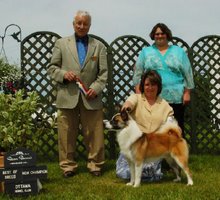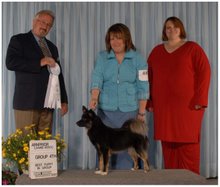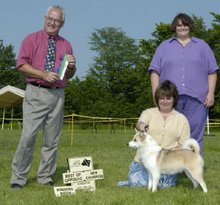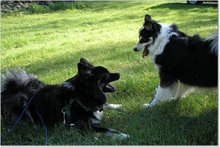
Hello Folks
Well was visiting with Monika last night and we got talking about the Icelandic and Herding, in Iceland, as Monika and others explain to me, the dogs are used for driving and for being sent up into the hills to bring down the sheep, in the annual spring/Fall Sheep roundups. The Icelandic Sheep is a very low flocking sheep, while some sheep breeds seen in Canada, would be consider med flocking (like my own sheep) and some would be considered good or even heavy flockers, which are very use to and wanting to "bunch" together, and this means that the dogs being very smart, and as they learn on different sheep in different parts of the world, working the sheep as needed for that landscape, would learn to be adjust their Herding style at least up to point..
Case in point, Dalla was born in Iceland, and she certainly shows the natural ability to drive, but given that my farm is on flat (mostly) pasture, and that I am working with my dogs in a much smaller fenced in pasture area's (thinking working in pens), working with the sheep in the big barn, and the other main, is working with me as a living moving fence line, as I still have pasture to graze, that is not fenced yet.. always a work in progress.. So to a point I am asking for driving, in the sense of moving the sheep with me to the grazing fields or back to the barn, the issue becomes when the sheep decide to go around me, or take off for the other hundred acres of hay that happens to belong to my neighbour, which is not part of my plan.. now if my dogs really only drove the sheep, we would have a bit of problem here, as I don't have a horse to go round them up, and its just me out there, not a group of peaple, but thankfully the Icelandic is smart, and wanting to work with me, is able to figure out that I want her to "go round" and to bring them back to me.. now that is a typical herding trait, and the Icelandic's do it as a upright(standing up) Barking (giving voice) running breed, which is what the standard calls for..
Same as in the barn, If coming in the front door, you need to go back different sets of stalls and of course the pen that holds all the metal garable cans filled with feed (the cans are to keep the feed dry, clean and mice free), which as you can imagine is a major draw, as the sheep know! that is where the grain is keep, and they want to try and go there.. honestly as the sheep do not feel the need to flock together, in the barn or outside (often willing to split into two or more groups as grazing) I rely on the dogs I have out and are working with to keep them together and to follow my commands, example in the barn, Dalla will push the sheep towards the barn, and I want this, but at the barn, I need to open the door, then back off to let the sheep in, at that point, I want Dalla to stay at the door, one, so the sheep don't go back out, and two so I can get to the end of the barn to open the door to the back barn which is where the sheep go.. so at that point, I can tell Dalla, Ok, push them, and she will make them all come down the barn and into their pen, now I know you are thinking this sounds so simple, and it can be.. but trust me, before I had a trained dog that would listen, or the odd time when I don't have dog with me, and I go to put them away, I have truly spent half an hour going around the barn or fields, trying to get sheep that do not want to in yet into the barn and into their pens..
My favorite was I had all the doors open and pens gates ready and I had been going around and around, the group split into two, which did not help, they were all on my hay fields no issue there, just that I wanted to put them away for the night.. finally I went stopping to house, and I threw open the door and said, Dalla Sheep, Barn.. and I am not kidding, she had them in rounded up, drove and into the barn and into their pen by the time I walked into the barn.. and I just patted her and shut the gate..
So I guess, the question Monika asks is important, if the dogs "drive" in Iceland, and are not trained so much as used with instinst and men on horse back to help, and in other coutries, they have different sheep (different flocking) and different landscape, there for different needs, and the dogs adapt to that, how do we make sure we are breeding and picking the next generation to have the herding instinct that Iceland born dogs have..
The answer is multi faced for sure.. and I am not sure anyone will have a true answer at this point, only time will tell.. I think that keeping the natural herding instincts within the breed is important, but I do think that using the dogs on different sheep, in different landscape, on different animals, (example, used to herd Cattle in Montana, and she swears that her ISD herd like her borders, now is that because the dog was raised with borders?) or the folks around that world that use the dogs to work with their horses, they are clearly "driving " the horse, so that comes quite naturally for sure, but they still do it as an icelandic.. I have an ISD on a horse farm in Alberta, and he does wonderful with them.
I think for me, I hope that by doing a formal puppy temperment test and keeping records on all the Greenstone adult Icelandics and the puppy test results, I will be able to do two things, one figure out what puppies and lines are being born with the most "natural driving" seen and used in Iceland for working their sheep and landscape, and also using the tests to figure out what Puppies and lines are born with the natural instincts to figure out what is required here and now, and therefor will learn what each sheep, horse or cattle needs.
What Monika and I came to, is that once again this breed is smart enought that with the right placement and owners, that ISD's can learn to do what is needed..
Got to love them. Greenstone Ada HI (pointed) working with flocking sheep in Ontario
Barks







No comments:
Post a Comment